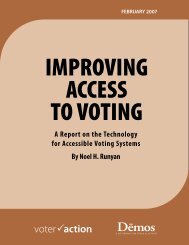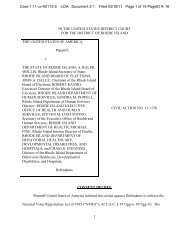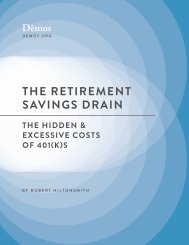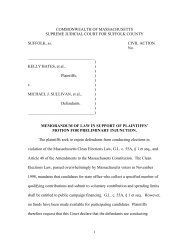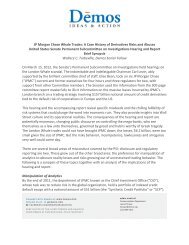Philip Harvey - Demos
Philip Harvey - Demos
Philip Harvey - Demos
You also want an ePaper? Increase the reach of your titles
YUMPU automatically turns print PDFs into web optimized ePapers that Google loves.
constructed, two thirds of them schools. Almost 2300 miles of sewer lines were laid or<br />
repaired. Swamp-drainage projects to ght malaria employed 30,000 CWA workers, and<br />
17,000 unemployed coal miners were employed sealing abandoned coal mines to protect<br />
ground-water supplies. Over 3700 playgrounds and 200 public swimming pools were<br />
constructed along with countless comfort stations, park benches and water fountains.<br />
e CWA’s white collar projects included education projects within existing schools<br />
that provided jobs for 50,000 laid-o teachers. Another 13,000 kept small rural schools<br />
open through the winter when normally they would have closed. irty-three thousand<br />
teachers were employed in adult education classes and in program-operated pre-schools.<br />
e adult classes served 800,000 learners and the pre-schools were attended by 60,700<br />
children.<br />
WHAT WOULD A DIRECT PUBLIC JOB STRATEGY LOOK LIKE?<br />
Direct job creation isn’t a new idea to the United States. A direct jobs program was rst<br />
enacted by President Roosevelt in late 1933 to counter the record unemployment levels<br />
of the Great Depression, prime the pump of business and tame growing political unrest.<br />
A modern direct job-creation program faces new challenges, but could include the<br />
following characteristics:<br />
Direct Administration. A variety of administrative structures are possible and<br />
mutually compatible, but projects would generally be undertaken by the federal<br />
government and agencies in partnership with local governments. Precautions<br />
would be required to prevent local ocials from using the program to replace<br />
public employees with federally-funded program workers. Contracting with nonprot<br />
organizations would also be possible.<br />
Reasonable Pay and Benets. e jobs would ideally pay approximately the same<br />
wage that persons with similar qualications and experience earn in the regular<br />
labor market. It would also provide employer-provided health insurance, child care<br />
services, guaranteed paid sick leave, and access to the Earned Income Tax Credit<br />
and SNAP for low earners.<br />
HOW CAN WE AFFORD DIRECT JOB CREATION?<br />
A million jobs could be created for a total budget ed cost of $46.4 billion per year. e same<br />
$46.4 billion in program spending would also trigger a multiplier eect that would create<br />
an additional 414,000 jobs outside the program. e damage widespread unemployment<br />
is inicting on the federal budget demands the question: how can we aord to not put<br />
Americans back to work? In fact, because direct job creation would make more Americans<br />
taxpayers again, the net cost of the a $46.4 billion proposal would be $17.8 billion lower<br />
than the initial outlay.<br />
e cost to produce the 8.2 million jobs needed to put Americans back to work would<br />
be $235 billion. If the Bush-era tax cuts had been allowed to expire at the end of 2010,<br />
the federal government would have collected about $295 billion in additional revenue<br />
during 2011. is would have been more than enough to cover the cost of the jobs<br />
program. Moreover, using the Bush-era tax cut money in this way would also increase<br />
4 Back to Work: A Public Jobs Proposal for Economic Recovery




